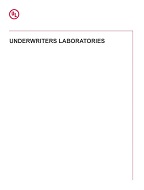Description
UL 157 – Gaskets and Seals
Please note: All interim revisions for this edition available at time of your purchase will be included.
Gaskets and Seals
UL 157
These requirements cover test procedures and performance criteria for the evaluation of nonmetallic gasket and seal materials such as elastomers, composite gasketmaterial, flexible cellular material, thermoplastics and thermoplastic elastomers for specific end products.
The general use of these gasket and seal materials is to exclude or hold within an enclosure materials that are liquid, gas, or vapor.
The materials covered in this standard are incomplete in certain construction features or restricted in performance capabilities, and are intended for use ascomponents in complete equipment.
This standard covers gaskets and seals as:
- Elastomers, thermoplastics and thermoplastic elastomers in the form of solid sheets, flexible cellular sheets, slabs, rolls, or parts, “O” rings, seats, shaft seals, and special forms.
- Composite gaskets in the form of sheets, rolls and cut forms of the types described in .
- Coated fabrics in the form of elastomers reinforced with fabrics in sheets or diaphragm form.
The gaskets and seals are evaluated for various properties to provide profile information – see Table . They are also evaluated for specific end-use applications – seeTable . Table specifies the oven aging required for establishing the maximum temperature for an expected use.
A product that contains features, characteristics, components, materials, or systems new or different from those covered by the requirements in this standard, and thatinvolves a risk of fire, electric shock, or injury to persons shall be evaluated using the appropriate additional component and end-product requirements as determinednecessary to maintain the acceptable level of safety as originally anticipated by the intent of this standard. A product whose features, characteristics, components,materials, or systems conflict with specific requirements or provisions of this standard cannot be judged to comply with this standard. Where considered appropriate,revision of requirements shall be proposed and adopted in conformance with the methods employed for development, revision, and implementation of this standard.
Product Details
- Edition:
- 2nd
- Published:
- 03/08/1996
- Number of Pages:
- 38
- Note:
- This product is unavailable in Ukraine, Russia, Belarus

